| Srl | Item |
| 1 |
ID:
110975
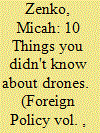

|
|
|
|
|
| Publication |
2012.
|
| Summary/Abstract |
In 1998, U.S. President Bill Clinton's administration shut down an operation to kill the al Qaeda leader in Afghanistan with cruise missiles, given collateral damage estimates of 300 casualties and only 50 percent confidence in the intelligence. As the 9/11 Commission noted, "After this episode Pentagon planners intensified efforts to find a more precise alternative." In 2000 and 2001, the U.S. Air Force struggled to reconfigure a Hellfire anti-tank missile to fit onto a Predator surveillance drone. Meeting one week before the 9/11 attacks, the National Security Council agreed that the armed Predator was not ready to be operationally deployed. The first known killing by armed drones occurred in November 2001, when a Predator targeted Mohammed Atef, a top al Qaeda military commander, in Afghanistan.
|
|
|
|
|
|
|
|
|
|
|
|
|
|
|
|
| 2 |
ID:
077338
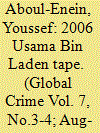

|
|
|
|
|
| Publication |
2006.
|
| Summary/Abstract |
Editor's Note: This essay is an excellent example of why we should be reading and analyzing the public messages of our opponents. Too often we dismiss the statements of Bin Laden and other criminal-soldiers as pure rhetoric and propaganda. In our struggle against Al-Qaeda and other criminal-state entities it is imperative that we know and understand the leadership of 'thine enemy' in order to disrupt, dismantle, and ultimately defeat them.
This essay discusses the rationale behind Usama Bin Laden's January 2006 tape, released by the Al-Qaeda leader after a 13 month hiatus. The essay puts forward theories behind the timing of the release of the tape and highlights Bin Laden's changes in strategic thought in response to changes in the political landscape of the Middle East. Bin Laden has also been carefully monitoring the anti-war movement and, for the first time, urges Americans to read an American author as a means of understanding his geo-political desires for the Muslim world. Readers will also be able to place Bin Laden's January 2006 tape in the context of recent statements by Ayman Al-Zawhairi and Abu Musab Al-Zarqawi
|
|
|
|
|
|
|
|
|
|
|
|
|
|
|
|
| 3 |
ID:
112196


|
|
|
| 4 |
ID:
022679
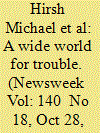

|
|
|
|
|
| Publication |
Oct 28, 2002.
|
| Description |
16-27
|
|
|
|
|
|
|
|
|
|
|
|
|
|
|
|
| 5 |
ID:
188254
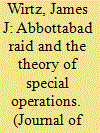

|
|
|
|
|
| Summary/Abstract |
When ‘The Theory of Special Operations’ was written in 1993 by then Commander William H. McRaven, USN, Al Qaeda was barely on the strategic horizon. Nevertheless, this thesis helped shape the denouement of the horrible tragedy that befell the world on 11 September 2001. This article describes McRaven’s work and traces its influence on the 2011 Abbottabad Raid. It also identifies how the theory might be modified to better capture the civil-military nexus at the apex of the strategic use of special operations forces.
|
|
|
|
|
|
|
|
|
|
|
|
|
|
|
|
| 6 |
ID:
106617
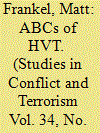

|
|
|
|
|
| Publication |
2011.
|
| Summary/Abstract |
The use of high value targeting (HVT)-using military and police forces to kill or capture leaders of insurgent and terrorist groups-has increased exponentially since the terrorist attacks of September 11, 2001. HVT operations have become the primary tool of the United States for combating Al Qaeda and its affiliates worldwide, and while these operations have eliminated scores of terrorists and insurgents from the battlefield, they haven't always led to strategic success. Utilizing a data set of 20 distinct HVT campaigns dating back to the end of World War II, this article will highlight the positive and negative effects of HVT efforts throughout history and identify six key lessons from past campaigns and their implications for the United States. The body of the paper looks at the important issues inherent to any HVT campaign, including the benefits of having a local force carry out the campaign, the importance of incorporating HVT into a larger counterinsurgency strategy, and the necessity of understanding the dynamics of the group being targeted. The United States has historically struggled in all of these areas, leading to difficulties in achieving success through HVT operations, but these historical lessons also provide opportunities for progress. The article concludes with important implications for the United States and identifies strategies for improvement in these pivotal areas, including expanding relationships with host governments, leveraging new technologies, and contemplating unique ways to approach target sets. Failure to make these changes, the article argues, will leave the United States with the same strategic failures it had with the infamous "deck of cards" in Iraq, where the focus on HVT at the expense of counterinsurgency both helped create and failed to stop the spread of a nationwide insurgency.
|
|
|
|
|
|
|
|
|
|
|
|
|
|
|
|
| 7 |
ID:
076935
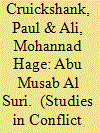

|
|
|
|
|
| Publication |
2007.
|
| Summary/Abstract |
Drawing on new sources, the authors argue that Abu Musab al Suri (real name Mustafa Setmariam Nasar), now in U.S. custody, is the principle architect of Al Qaeda's post-9/11 structure and strategy. His vision, which predated 9/11, of transforming Al Qaeda from a vulnerable hierarchical organization into a resilient decentralized movement, was largely the formula Al Qaeda adopted after the collapse of the Taliban. The authors show how Setmariam, whose ideas have been disseminated widely on the Internet and whose disciples have gravitated to leadership positions in the international jihad, has influenced Al Qaeda's post-9/11 strategy, targeting, and doctrine.
|
|
|
|
|
|
|
|
|
|
|
|
|
|
|
|
| 8 |
ID:
115492
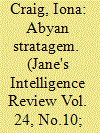

|
|
|
| 9 |
ID:
118204
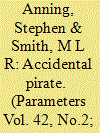

|
|
|
| 10 |
ID:
129880
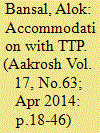

|
|
|
| 11 |
ID:
084338


|
|
|
|
|
| Publication |
2008.
|
| Summary/Abstract |
Can Kabul be saved? More troops are on the way, but a one-size-fits-all surge is not enough. We also need to change our tactics. If Washington wants to prevail in Afghanistan, we need to learn from successes in Iraq, and focus on fighting a war-not building a nation.
|
|
|
|
|
|
|
|
|
|
|
|
|
|
|
|
| 12 |
ID:
113594
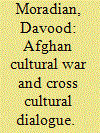

|
|
|
| 13 |
ID:
107147
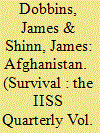

|
|
|
|
|
| Publication |
2011.
|
| Summary/Abstract |
The overarching Western objective in Afghanistan should be to prevent that country from becoming not just a haven for transnational terrorists, but a terrorist ally as well. That was the situation prior to 9/11 and it would be so again if the Taliban returned to power with al-Qaeda backing. NATO can prevent this indefinitely as long as it is willing to commit significant military and economic resources to a counter-insurgency effort. It cannot eliminate the threat, however, as long as the Afghan insurgents enjoy sanctuary in and support from Pakistan. Alternatively, this objective could be achieved if the Taliban could be persuaded to cut its ties to al-Qaeda and end its insurgency in exchange for some role in Afghan governance short of total control.
|
|
|
|
|
|
|
|
|
|
|
|
|
|
|
|
| 14 |
ID:
108407
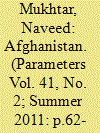

|
|
|
| 15 |
ID:
102022
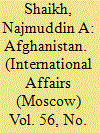

|
|
|
|
|
| Publication |
2010.
|
| Summary/Abstract |
FOR THE LAST FEW DAYS following the "Rolling Stones" interview by Gen. McChrystal and President Obama's decision to replace him with Gen. Petraeus there has been a great deal of attention paid to the current situation in Afghanistan and what the change in command will portend for the strategy that Gen McChrystal had devised to achieve President Obama's goal of disrupting, dismantling and defeating the Al-Qaeda network and ensuring that Afghanistan did not again become a safe haven for terrorists intent on attacking the United States and its allies. By and large, the comments have welcomed the Petraeus appointment as the best option available but they also suggest whatever Gen. McChrystal's faults the military at least had unity of command while the U.S. civilian team was not working together smoothly, that little progress had been made in improving the quality of governance in Afghanistan and therefore that the United States is losing the war in Afghanistan. More and more these reports and commentaries suggest that the American will to continue in Afghanistan is wilting partly because public opinion is no longer willing to support it and partly because the leaders too believe that this has become an unwinnable war.
|
|
|
|
|
|
|
|
|
|
|
|
|
|
|
|
| 16 |
ID:
118719


|
|
|
| 17 |
ID:
126302
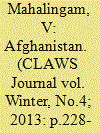

|
|
|
| 18 |
ID:
128389
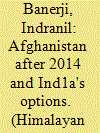

|
|
|
|
|
| Publication |
2011.
|
| Summary/Abstract |
Current speculation on the future of Afghanistan revolves around 2014, the year US forces are supposed to finally end their Afghan War mission. The key question is what will happen once the Americans depart? What sort of Afghanistan would emerge after that? Would the Taliban once again overrun that country and establish a ruthless Islamic emirate? Or would the pro-West regime in Kabul survive with the aid of the fledgling Afghan National Army and police? And where would all that leave India?
|
|
|
|
|
|
|
|
|
|
|
|
|
|
|
|
| 19 |
ID:
112822
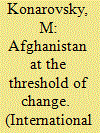

|
|
|
|
|
| Publication |
2012.
|
| Summary/Abstract |
ON DECEMBER 5, 2011, Bonn hosted a large-scale International Afghanistan Conference under the slogan "Afghanistan and the International Community: From Transition to the Transformation Decade" attended by high representatives of about 100 countries and international organizations, in short, practically the entire range of the world community. The conference met to look at ten years of post-Taliban development and reconfirm a broad international consensus on the Roadmap of the country's development after the draw-down of American and NATO contingents launched in the summer of 2011 and expected to be completed in 2014.
|
|
|
|
|
|
|
|
|
|
|
|
|
|
|
|
| 20 |
ID:
109542
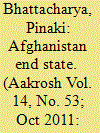

|
|
|